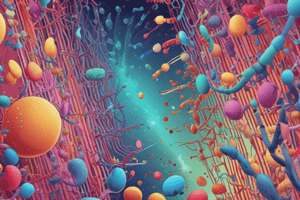Podcast
Questions and Answers
What color change is observed when orinithine is converted to putrescine by the enzyme ODC?
What color change is observed when orinithine is converted to putrescine by the enzyme ODC?
- Yellow to red (correct)
- Red to yellow
- Blue to green
- Green to blue
Which enzyme produces indole from tryptophan?
Which enzyme produces indole from tryptophan?
- Tryptophan deaminase (correct)
- UREase
- Citrate
- Orinithine decarboxylase
What color change is observed when citrate is utilized as a carbon source?
What color change is observed when citrate is utilized as a carbon source?
- Red to yellow
- Yellow to red
- Blue to green
- Green to blue (correct)
In the Voges-Proskauer test, what is detected as a result of acetone production?
In the Voges-Proskauer test, what is detected as a result of acetone production?
Which enzyme liquefies gelatin and produces a black color dye?
Which enzyme liquefies gelatin and produces a black color dye?
What is the end product of tryptophan consumption by TDA enzyme?
What is the end product of tryptophan consumption by TDA enzyme?
What is the end result of H2S production when it reacts with iron?
What is the end result of H2S production when it reacts with iron?
Study Notes
Antibiotic Sensitivity Test
- Antibiotic sensitivity test is a standardized method to measure the effectiveness of antibiotics and chemotherapeutic agents on pathogenic microorganisms.
- It is essential for describing appropriate treatment.
Types of Antibiotics
- Antibiotics: Produced by some microbes naturally as a by-product of their metabolic activities, and have the ability to inhibit or kill other types of microbes (e.g., Penicillin and Cephalosporin).
- Synthetic agents: Completely synthesized in laboratories by chemical processes unrelated to microbial activity (e.g., Ciprofloxacin).
- Semi-synthetic agents: Natural antibiotics that have been chemically modified (e.g., Ampicillin).
Mechanisms of Action of Antibiotics
- Inhibit cell wall synthesis (e.g., Penicillin).
- Inhibit cytoplasmic membrane (e.g., Colistin).
- Inhibit protein synthesis (e.g., Tetracycline).
- Inhibit nucleic acid synthesis (e.g., Rifamycin).
- Inhibit folic acid synthesis (e.g., Sulfonamides).
Spectrum of Action
- Narrow spectrum drugs: Effect against only a few kinds of pathogens (e.g., Penicillin, affecting only gram-positive bacteria).
- Broad spectrum drugs: Effect against many different kinds of pathogens (e.g., Ampicillin).
Microbial Culture Test
- Demonstration of pathogenic organisms in the patient specimen is the most definitive test in microbiology.
- Many bacteria, fungi, parasites, and viruses can be grown in a lab when appropriate conditions are used.
- Common specimens include blood, urine, sputum, stool, pus, and swabs (throat, nasal, ear, eye, and cervical).
Routine Microbiology Specimen Collection Procedures
- Obtain complete patient information, including name, source of specimen, collection date, and test desired.
- Collect specimens correctly, using a sterile container and labeling correctly.
- Avoid contamination of the container and send the specimen to the laboratory promptly.
Antibiotic Sensitivity Test Results
- Sensitive: Clear, circular "halo" (zone of inhibition) appears around the antibiotic disk, indicating the antibiotic has inhibited bacterial growth and killed them.
- Intermediate: Somewhat cloudy zone indicates some bacteria are sensitive to the antibiotic, while others are genetically immune.
Fungal Culture
- 30°C is the optimal temperature for isolating fungi from clinical specimens.
- Dimorphic fungi are cultured at 30°C for the growth of mold form and 37°C for the growth of yeast form.
- Colony characteristics include color, texture, and rate of growth.
- Microscopic examination of culture includes septate or aseptate hyphae, hyaline or dematiaceous hyphae, fruiting structures, and conidia.
Identification of Culture
- Colony characteristics include color, texture, and rate of growth.
- Microscopic examination of culture includes septate or aseptate hyphae, hyaline or dematiaceous hyphae, fruiting structures, and conidia.
Biochemical Tests
- Ornithine decarboxylase (ODC): Converts ornithine to putrescine, raising the pH and changing the color from yellow to red.
- Citrate (CIT): Utilization of citrate as a source of carbon results in a change in the pH and a change in the color from green to blue.
- H2S production: Reacts with iron to form a black precipitate.
- URE: Tests for the enzyme urease, which consumes urea to produce ammonia and changes the color from yellow to red.
- Tryptophan deaminase (TDA): Consumes tryptophan to produce indole and pyruvic acid, and in the presence of iron chloride, a red-brown color is formed.
- Indole Test (IND): Detects production of indole from tryptophan by the enzyme tryptophanase.
- Voges-Proskauer test (VP): Detects acetone produced by fermentation of glucose by bacteria.
- GEL: Tests for the production of the enzyme gelatinase, which liquefies gelatin and produces a black color.
- Consumption of carbohydrates: Produces acid that changes the color of the index from blue to yellow.
Studying That Suits You
Use AI to generate personalized quizzes and flashcards to suit your learning preferences.
Description
Test your knowledge on the standardized method used to measure the effectiveness of antibiotics and chemotherapeutic agents on pathogenic microorganisms. Explore different types of drugs based on their composition and origin, such as antibiotics like Penicillin, Cephalosporin, and synthetic agents.




